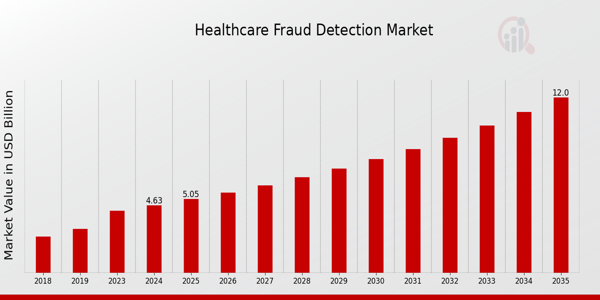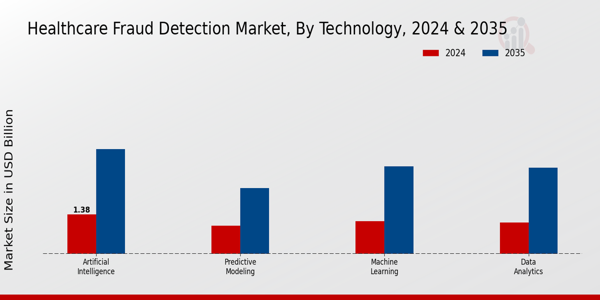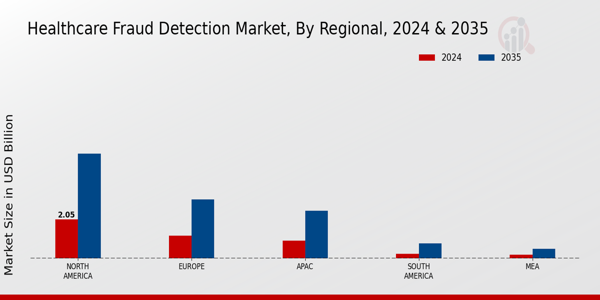Healthcare Fraud Detection Market Overview
As per MRFR analysis, the Healthcare Fraud Detection Market Size was estimated at 4.24 (USD Billion) in 2024.The Healthcare Fraud Detection Market Industry is expected to grow from 4.63(USD Billion) in 2025 to 12 (USD Billion) by 2035. The Healthcare Fraud Detection Market CAGR (growth rate) is expected to be around 9.05% during the forecast period (2025 - 2035).
Key Healthcare Fraud Detection Market Trends Highlighted
The Global Healthcare Fraud Detection Market is experiencing significant growth driven by the increasing incidence of healthcare fraud and the rising number of fraudulent claims. This urgency has pushed healthcare providers and insurers to invest more in advanced detection technologies such as artificial intelligence and machine learning. These technologies help in analyzing vast amounts of data quickly and accurately, leading to the identification of unusual patterns that may indicate fraud. This increase in technological adoption is a crucial trend shaping the market. Furthermore, the recent advancements in data analytics tools have opened new opportunities for stakeholders in the global healthcare sector.
Organizations are leveraging advanced algorithms and predictive analytics to prevent and combat fraud effectively. The integration of real-time analytics in healthcare systems is helping to detect anomalies at an early stage, offering a proactive approach to fraud management. As healthcare costs continue to rise, these opportunities for innovation become essential for enhancing fraud prevention strategies. In recent times, there has been a noticeable shift towards regulatory compliance and the implementation of stringent policies by governments worldwide to curb fraudulent practices.
Various countries are enhancing their regulations, requiring healthcare organizations to adopt robust fraud detection systems.Additionally, stakeholder collaboration, including partnerships between public health authorities and private entities, is fostering a more comprehensive approach to tackling healthcare fraud. These trends collectively indicate a growing commitment to establishing more secure and effective healthcare systems on a global scale, ensuring that financial resources are allocated appropriately to areas of need.

Source: Primary Research, Secondary Research, MRFR Database and Analyst Review
Healthcare Fraud Detection Market Drivers
Increasing Incidence of Fraud in Healthcare
The Global Healthcare Fraud Detection Market Industry is experiencing exponential growth primarily due to the increasing incidence of fraud and abuse within healthcare systems worldwide. According to the National Health Care Anti-Fraud Association, healthcare fraud costs the United States more than 68 billion USD annually. With such staggering figures, healthcare systems across the globe are increasingly under pressure to implement robust fraud detection mechanisms.This alarming trend has prompted institutions such as the World Health Organization to advocate for stricter fraud detection methodologies, fostering an environment conducive to growth in the Global Healthcare Fraud Detection Market.
Amid rising fraud cases, enterprises are investing in advanced technologies such as Artificial Intelligence (AI) and Machine Learning (ML) to enhance fraud detection capabilities, making this an essential focus for healthcare providers and insurers alike.The World Health Organization indicates that improperly reported claims can lead to an annual loss of roughly 10% of a country's healthcare expenditure, highlighting the importance of adopting effective fraud detection systems globally.
Government Initiatives and Regulations
Increasing government initiatives aimed at combating healthcare fraud significantly drive the Global Healthcare Fraud Detection Market Industry. Various governments are introducing stricter regulations, incentivizing healthcare organizations to adopt better fraud detection technologies. For example, recent policy changes in the United States have strengthened compliance with the Affordable Care Act, mandating healthcare organizations to adopt advanced fraud analytics.In Europe, the European Union has established the European Health Insurance Card, which aims to reduce healthcare fraud across member states. These regulatory pushes not only establish a framework for better fraud detection but also set legal repercussions for non-compliance, further driving market growth.
Technological Advancements in Fraud Detection Tools
The surge in technological advancements plays a crucial role in propelling the Global Healthcare Fraud Detection Market Industry forward. Innovations such as Predictive Analytics, AI, and Blockchain technology are reshaping how healthcare organizations monitor and prevent fraud. A report from the Institute of Medicine shows that about 30% of healthcare spending is deemed wasteful due to fraud and inefficiencies. By implementing sophisticated fraud detection systems that leverage AI and Predictive Analytics, organizations can significantly reduce these inefficiencies.Furthermore, the integration of Blockchain technology is becoming increasingly recognized as a viable method to enhance data integrity and track claims in real time, thereby creating a transparent environment and reducing fraud risk.
Rising Awareness Among Consumers
Consumer awareness regarding healthcare fraud is rapidly increasing, driving demand for effective fraud detection solutions within the Global Healthcare Fraud Detection Market Industry. With recent campaigns initiated by various health departments and organizations, the public is becoming more knowledgeable about their rights and the mechanisms of healthcare fraud. In fact, a survey conducted by the Centers for Medicare Medicaid Services revealed that nearly 40% of consumers have experienced or witnessed healthcare fraud.This increased awareness empowers consumers to report fraudulent activities, thereby placing additional pressure on healthcare providers to enhance their fraud detection systems. This paradigm shift is transforming consumer engagement in fraud prevention, contributing significantly to market growth.
Healthcare Fraud Detection Market Segment Insights
Healthcare Fraud Detection Market Technology Insights
The Global Healthcare Fraud Detection Market, particularly within the Technology segment, demonstrates substantial growth potential, with a notable valuation of 4.63 USD Billion in 2024, projected to reach 12.0 USD Billion by 2035. This market is heavily influenced by technological advancements, especially in areas such as Artificial Intelligence, Machine Learning, Data Analytics, and Predictive Modeling, which collectively shape the future of healthcare fraud prevention. The Artificial Intelligence component alone is valued at 1.38 USD Billion in 2024 and is expected to grow significantly to 3.65 USD Billion by 2035, highlighting its essential role in analyzing complex data patterns that reveal fraudulent activities.
Machine Learning, valued at 1.15 USD Billion in 2024, is anticipated to expand to 3.05 USD Billion in 2035, emphasizing its capacity to continually improve detection algorithms through experience and data. Furthermore, Data Analytics 1.1 USD Billion in 2024, with projections of rising to 3.0 USD Billion in 2035, showcasing its importance in processing and interpreting vast amounts of healthcare data to identify anomalies indicative of fraud. Predictive Modeling, although the smallest segment at 0.99 USD Billion in 2024, is expected to grow to 2.3 USD Billion by 2035, signifying its crucial function in forecasting and mitigating risks associated with healthcare fraud.
The integration of these technologies is driven by the need for enhanced efficiency and accuracy in detecting fraudulent claims, meeting a growing demand within the Global Healthcare Fraud Detection Market. As regulatory bodies increase their focus on compliance and fraud prevention, the importance of these technological advancements becomes clear, positioning them as vital tools in safeguarding financial integrity in the healthcare industry. Global efforts to combat healthcare fraud are being bolstered by state-of-the-art solutions in technology, indicating a strong market trend toward embracing innovation for enhanced fraud detection and prevention mechanisms.
With continued investment in these advanced technologies, the Global Healthcare Fraud Detection Market is likely to experience substantial growth, reflecting the necessity of robust and adaptable solutions to counter the evolving challenges of healthcare fraud.

Source: Primary Research, Secondary Research, MRFR Database and Analyst Review
Healthcare Fraud Detection Market Component Insights
The Component segment of this market encompasses various vital elements, including Software, Hardware, and Services. Software solutions are increasingly becoming critical as they utilize advanced algorithms and artificial intelligence to detect fraudulent claims, providing healthcare organizations with essential tools to safeguard their financial resources. Hardware also plays a crucial role in securing systems and enhancing the efficiency of these applications.Furthermore, Services, including consulting and support, are instrumental in implementing effective fraud detection strategies to adapt to the constantly changing landscape of healthcare.
The rise in healthcare expenditure and the increasing complexity of healthcare billing systems are significant drivers fueling the Global Healthcare Fraud Detection Market growth. However, challenges such as data privacy concerns and the need for continuous adaptation to new fraudulent techniques present obstacles. Overall, the Global Healthcare Fraud Detection Market data indicates a strong growth trajectory, supported by a relentless demand for improved security and operational efficiency in healthcare systems.
Healthcare Fraud Detection Market Application Insights
The Application segment showcases vital areas such as Claim Verification, Provider Enrollment Screening, and Fraud Analytics. Claim Verification plays a critical role in validating claims submitted for payment, ensuring funds are directed towards legitimate services, thereby reducing overall losses. Similarly, Provider Enrollment Screening is significant as it verifies the credentials of healthcare providers, mitigating the risk associated with fraudulent practices that could affect patient care and financial integrity.Fraud Analytics employs advanced data analysis techniques to identify patterns associated with fraud, enabling proactive measures against potential threats.
These applications drive substantial advancements in the Global Healthcare Fraud Detection Market, contributing to its expected growth. The market is influenced by key factors such as the increasing adoption of technology in healthcare, rising healthcare costs, and growing demand for improved detection methods. However, challenges include the complexity of data integration and the need for continuous updates to combat evolving fraudulent schemes.Overall, the segmented approaches in this market underscore the importance of targeted solutions in safeguarding healthcare resources.
Healthcare Fraud Detection Market Deployment Mode Insights
The Global Healthcare Fraud Detection Market is witnessing significant growth, particularly in the Deployment Mode segment, which encompasses both On-Premise and Cloud-Based solutions. On-premise deployment provides organizations with direct control over their infrastructure, appealing to those concerned about compliance and data security. Conversely, Cloud-Based solutions are gaining traction due to their scalability, cost-effectiveness, and ease of implementation, allowing healthcare providers to adapt quickly to evolving fraud schemes.The demand for efficient fraud detection methods is driven by regulatory pressures and the need for enhanced patient data integrity.
According to Global Healthcare Fraud Detection Market statistics, this segment is crucial as it caters to diverse operational needs, enabling organizations to handle vast amounts of data effectively. The increasing prevalence of healthcare fraud is pressing organizations to adopt robust solutions, creating a competitive landscape for On-Premise and Cloud-Based technologies. As a result, the Deployment Mode segment stands to dominate the market, reflecting broader trends in data management and security practices across the global healthcare industry.
Healthcare Fraud Detection Market Regional Insights
North America stands out, holding a majority with a valuation of 2.05 USD Billion in 2024 and expected to rise to 5.5 USD Billion by 2035, driven by stringent regulations and advanced technologies in fraud detection. Europe follows, showcasing a valued market of 1.2 USD Billion in 2024 and an expected increase to 3.1 USD Billion, largely due to increasing investment in cybersecurity and fraud prevention.In the APAC region, the market is valued at 0.93 USD Billion in 2024, with projections reaching 2.5 USD Billion by 2035, as governments increasingly prioritize healthcare integrity and efficiency.
South America and MEA represent nascent yet growing markets, valued at 0.25 USD Billion and 0.2 USD Billion in 2024, respectively, and moving towards 0.8 USD Billion and 0.5 USD Billion by 2035. While the Global Healthcare Fraud Detection Market faces challenges such as limited technology adoption in emerging areas, significant opportunities arise from increasing awareness and government initiatives aimed at combating healthcare fraud across all regions.This segmentation reveals strategic insights into the dynamics of healthcare fraud detection and underscores the importance of regional adaptation to address specific challenges and leverage growth opportunities.

Source: Primary Research, Secondary Research, MRFR Database and Analyst Review
Healthcare Fraud Detection Market Key Players and Competitive Insights
The Global Healthcare Fraud Detection Market is witnessing increasing competitiveness as organizations strive to combat the growing issue of fraudulent activities in the healthcare sector. The rise of technology, combined with regulatory demands and the need for transparency in healthcare transactions, has spurred the development of innovative fraud detection solutions. Companies are focused on enhancing their detection capabilities through advanced analytics, artificial intelligence, and machine learning methodologies. A diverse range of stakeholders, including healthcare providers, payers, and government entities, are investing in these solutions to ensure compliance, reduce financial losses, and safeguard patient trust.
As this market continues to evolve, understanding the competitive landscape becomes crucial for identifying opportunities and potential threats.IBM holds a significant position in the Global Healthcare Fraud Detection Market through its robust suite of analytics-driven solutions designed to help organizations identify and prevent fraudulent behaviors. Leveraging its expertise in cognitive computing and data analysis, IBM provides healthcare providers and payers with tools that enable them to analyze vast amounts of data to uncover patterns indicative of fraud. The company's strengths lie in its well-established research and development capabilities, enabling the continuous enhancement of its fraud detection technologies.
Additionally, IBM's strategic partnerships and collaborations with healthcare organizations enhance its market presence, positioning it as a thought leader capable of delivering personalized solutions tailored to the unique challenges faced by the healthcare industry globally.NICE Actimize has established itself as a key player in the Global Healthcare Fraud Detection Market by offering a comprehensive portfolio of solutions that include fraud detection, compliance management, and risk mitigation services. The company focuses on integrating advanced analytics and machine learning to streamline the identification of potentially fraudulent claims and behaviors within healthcare organizations.
NICE Actimize stands out for its customer-centric approach, which emphasizes the development of scalable solutions that can be tailored to fit the specific needs of its clients. The company’s commitment to innovation is reflected in its ongoing research and development efforts, which include mergers and acquisitions aimed at expanding its product offering and market reach. With robust industry partnerships and a strong presence in the global market, NICE Actimize continues to enhance its reputation as a leading provider of healthcare fraud detection solutions, well-positioned to navigate the complexities of the ever-evolving healthcare landscape.
Key Companies in the Healthcare Fraud Detection Market Include
- IBM
- NICE Actimize
- HCSC
- Cerner
- Quest Diagnostics
- Infinx Healthcare
- Cardinal Health
- Change Healthcare
- Ahmadiyya Health
- Cognizant
- SAS
- Verato
- Optum
- McKesson
- Anthem
Healthcare Fraud Detection Market Industry Developments
The Global Healthcare Fraud Detection Market has experienced significant developments recently, with growing attention on technological solutions to combat fraud in healthcare systems worldwide. Companies such as IBM, NICE Actimize, and Change Healthcare are at the forefront, employing advanced analytics and artificial intelligence to enhance fraud detection capabilities. In a notable move, Anthem announced the acquisition of a Healthcare analytics firm in January 2023 to bolster its fraud detection and prevention efforts.
In the previous years, Quest Diagnostics and Cerner launched collaborative strategies aimed at enhancing efficiency in fraud detection mechanisms, significantly impacting their market positions in mid-2022. Market valuations have been on an upward trajectory, driven by increasing awareness of healthcare fraud, leading to an estimated growth rate of over 15% annually as healthcare providers seek to safeguard their revenue cycles. The rising costs associated with healthcare fraud, projected to reach billions annually, are compelling organizations like Cardinal Health and McKesson to innovate their fraud detection processes. With a growing focus on regulations and compliance, the Global Healthcare Fraud Detection Market remains dynamic, indicating robust ongoing investment and development within this critical sector.
Healthcare Fraud Detection Market Segmentation Insights
Healthcare Fraud Detection Market Technology Outlook
- Artificial Intelligence
- Machine Learning
- Data Analytics
- Predictive Modeling
Healthcare Fraud Detection Market Component Outlook
- Software
- Hardware
- Services
Healthcare Fraud Detection Market Application Outlook
- Claim Verification
- Provider Enrollment Screening
- Fraud Analytics
Healthcare Fraud Detection Market Deployment Mode Outlook
Healthcare Fraud Detection Market Regional Outlook
- North America
- Europe
- South America
- Asia Pacific
- Middle East and Africa
| Report Attribute/Metric Source: |
Details |
| MARKET SIZE 2023 |
4.24(USD Billion) |
| MARKET SIZE 2024 |
4.63(USD Billion) |
| MARKET SIZE 2035 |
12.0(USD Billion) |
| COMPOUND ANNUAL GROWTH RATE (CAGR) |
9.05% (2025 - 2035) |
| REPORT COVERAGE |
Revenue Forecast, Competitive Landscape, Growth Factors, and Trends |
| BASE YEAR |
2024 |
| MARKET FORECAST PERIOD |
2025 - 2035 |
| HISTORICAL DATA |
2019 - 2024 |
| MARKET FORECAST UNITS |
USD Billion |
| KEY COMPANIES PROFILED |
IBM, NICE Actimize, HCSC, Cerner, Quest Diagnostics, Infinx Healthcare, Cardinal Health, Change Healthcare, Ahmadiyya Health, Cognizant, SAS, Verato, Optum, McKesson, Anthem |
| SEGMENTS COVERED |
Technology, Component, Application, Deployment Mode, Regional |
| KEY MARKET OPPORTUNITIES |
Advanced analytics technology adoption, Integration with AI and machine learning, Growing regulatory compliance requirements, Rising telehealth and digital services, Increasing awareness of healthcare fraud |
| KEY MARKET DYNAMICS |
Technological advancements in analytics, Increasing regulatory compliance pressure, Rising healthcare costs, Growing awareness of fraud, Enhanced data security measures |
| COUNTRIES COVERED |
North America, Europe, APAC, South America, MEA |
Healthcare Fraud Detection Market Highlights:
Frequently Asked Questions (FAQ) :
The projected market size for the Global Healthcare Fraud Detection Market in 2024 is 4.63 USD Billion.
By 2035, the market size for the Global Healthcare Fraud Detection Market is expected to reach 12.0 USD Billion.
The expected CAGR for the Global Healthcare Fraud Detection Market from 2025 to 2035 is 9.05%.
In 2024, North America is expected to hold the largest market share in the Global Healthcare Fraud Detection Market, valued at 2.05 USD Billion.
The market size for the Artificial Intelligence segment in the healthcare fraud detection technology is projected to be 1.38 USD Billion in 2024.
The market value of Predictive Modeling technology in the Global Healthcare Fraud Detection Market is expected to be 2.3 USD Billion by 2035.
Major players in the Global Healthcare Fraud Detection Market include IBM, NICE Actimize, Cerner, and McKesson among others.
The expected market size for the Data Analytics segment in the Global Healthcare Fraud Detection Market by 2035 is 3.0 USD Billion.
The South America region is expected to contribute 0.25 USD Billion to the Global Healthcare Fraud Detection Market in 2024.
Emerging trends in the Global Healthcare Fraud Detection Market include the adoption of advanced technologies like Artificial Intelligence and Machine Learning for fraud detection.


















